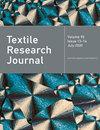用织物触感测试仪评估梭织衬衫面料的织物处理性能
IF 1.9
4区 工程技术
Q2 MATERIALS SCIENCE, TEXTILES
引用次数: 0
摘要
织物触感测试仪是一种具有织物处理特性的新型仪器。它的主要优点是设备集成了压缩、表面摩擦、热和弯曲性能模块。模块集成简化了测试过程,提供了高效的测量方法和全面的物理指标。这项研究主要针对礼服衬衫的梭织面料。织物样品由三组不同的纱线组成,即棉、涤纶和羊毛。样品组 1 由棉纱、涤纶纱和混纺纱组成;样品组 2 主要比较捻线纱对织物手感的影响;样品组 3 由羊毛和涤纶混纺纱组成。通过压缩功和压缩恢复率评估了压缩属性的处理特性。结果表明,高捻度纱线织物(T100p1)的压缩功值更高(242.56 gf*mm2),而且质地类型对压缩特性的影响可能比混纺比更明显。织物触感测试仪还能分辨出样品压缩特性的微小变化(0.43-0.71)、热特性和表面粗糙度特性的最大热通量和表面粗糙度振幅。结果显示,本研究中所有样品的最大热通量值均为 1109 Wm-2,其中使用纯棉纱的样品 C100 的最大热通量值最高(1270 Wm-2)。此外,使用 100% 羊毛纤维纱线的 W100 样品在经向的表面粗糙度幅度(81 μm)和纬向的表面粗糙度幅度(67 μm)最高。最后,弯曲平均刚度用于评估织物样品的弯曲性能。这些织物触感测试仪指标被用于分析梭织衬衫面料的织物处理特性,并进行样品间的交叉分析。本文章由计算机程序翻译,如有差异,请以英文原文为准。
Fabric handling evaluation of woven shirting fabrics by the fabric touch tester
A fabric touch tester is a novel instrument with fabric handling properties. Its principal advantage is that the device has integrated modules for compression, surface friction, and thermal and bending properties. This module integration simplifies the testing process, and provides an efficient measurement method, and a comprehensive physical index. This study focused on woven fabrics for dress shirts. The fabric samples comprised three groups with various yarn compositions – that is, cotton, polyester, and wool. Sample group 1 was composed of cotton, polyester, and blended yarns; sample group 2 mainly compared the effect of twist yarns on the fabric touch; and sample group 3 was composed of wool and blended yarns with polyester. The handling properties were assessed by compression work and the compression recovery rate for the compression attributes. The results revealed that fabric (T100p1) with high twist-level yarns had a higher value of compression work (242.56 gf*mm2 ), and the texture type may affect the compression characteristics more significantly than the blending ratio. The fabric touch tester can also distinguish small changes in the compression properties of samples (0.43–0.71), the maximum heat flux and surface roughness amplitude for the thermal and surface roughness properties. The results revealed that the maximum heat flux value of all the samples in this study was 1109 Wm−2 , the sample C100 using pure cotton yarn had the highest maximum heat flux value (1270 Wm−2 ). Moreover, the sample W100 with 100% wool fiber yarn had the highest surface roughness amplitude in the warp direction (81 μm) and surface roughness amplitude in the weft direction (67 μm). Finally, the bending average rigidity was used to assess the bending performance of the fabric samples. These fabric touch tester indicators were applied to analyze the fabric handling characteristics of woven shirting fabrics, and perform cross-analysis among samples.
求助全文
通过发布文献求助,成功后即可免费获取论文全文。
去求助
来源期刊

Textile Research Journal
工程技术-材料科学:纺织
CiteScore
4.00
自引率
21.70%
发文量
309
审稿时长
1.5 months
期刊介绍:
The Textile Research Journal is the leading peer reviewed Journal for textile research. It is devoted to the dissemination of fundamental, theoretical and applied scientific knowledge in materials, chemistry, manufacture and system sciences related to fibers, fibrous assemblies and textiles. The Journal serves authors and subscribers worldwide, and it is selective in accepting contributions on the basis of merit, novelty and originality.
 求助内容:
求助内容: 应助结果提醒方式:
应助结果提醒方式:


